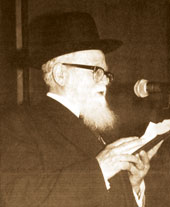
by HaRav Shaul Yisraeli, zt"l
based on Siach Shaul, p. 234-235
Bnei Yisrael arrived at Mt. Sinai with an encampment that is famously described as "like one man with one heart" (Rashi, Shemot 19:2). The unity, which was preparatory for the receiving of the Torah, is not just preparation but is the essence of the Torah. Unity in the world and in interpersonal relationships is not just a convenient means. It is the purpose and the essence of life for all that breathes.
That which Hashem is one is not just that He is unique numerically; it is an essential difference from other beings. His name is peace, just as His seal is truth. The self of a physical animalistic being relates to its interest in fulfilling physical desires, even if this contradicts the welfare of others. For us, the self is to be dedicated to that which is good, and this certainly includes active concern for others. It is not just a matter of fighting that which is bad, but of having goodness serve as an innate value.
The whole Torah can be summed up with "Love your friend as yourself" (Vayikra 19:18). That is not only a message for one who has come to convert (see Shabbat 31a). Once a person is inspired to care, even while he is enjoying tranquility, that there is someone in some place who needs him, that is the time that he cannot make due with a life of idolatry, where obtaining what one wants is the focus.
The internal quest for justice will not be satisfied until all the world is full of justice. A person does not want to see himself as an exception in creation, and if he believes in justice, he wants it to be pervasive.
He will want to see how Hashem handles matters of justice, although it is possible "to see Hashem" only from the back (see Shemot 33:23). When we are at the end of a historical episode and we want to check how things were divinely handled, we should be able to find the unity and the great hand of Hashem in it. We saw what happened to the Parohs of the world, to Amalek, Sisra, Sancheriv, and Titus. These were all-powerful people who eventually had to pay the price of their deeds. In historical hindsight we see how even these evil people played a role in what needed to happen in the world. However, we cannot see "Hashem’s face" (see ibid.). We have very limited vision. While we think we now see no justice, at the end we will be able to look back and get a better look at the whole picture.
Sometimes our more noble self dozes off and we see only ourselves and that which we want from the perspective of a lower level. We do not see the unity of creation and the imprint of Hashem within it. We break the world into little pieces in which each one fights for his survival. Human society becomes like that of the animal world. Then we are prone to asking the question, "Is Hashem in our midst or is He not?" The very question shows that the evil of the likes of Amalek, whose essence is that "he did not fear Hashem," exists.

No comments:
Post a Comment